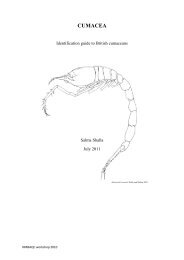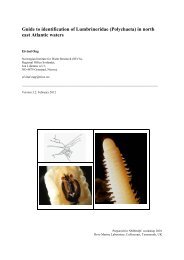s A Field Guide to the British Seaweeds - NMBAQC
s A Field Guide to the British Seaweeds - NMBAQC
s A Field Guide to the British Seaweeds - NMBAQC
You also want an ePaper? Increase the reach of your titles
YUMPU automatically turns print PDFs into web optimized ePapers that Google loves.
Nemalion helminthoides<br />
Plant very slippery, gelatinous, squashy and<br />
completely solid throughout growing up <strong>to</strong> 25cm long<br />
and 5mm wide; it may also be quite elastic.<br />
Branching is limited and irregular, with most<br />
branching occurring <strong>to</strong>wards <strong>the</strong> base of <strong>the</strong> plant. Is<br />
it frequently reddish brown in colour and is found<br />
attached <strong>to</strong> limpets and barnacles in <strong>the</strong> mid and<br />
lower lit<strong>to</strong>ral. It has a sou<strong>the</strong>rn distribution. It may be<br />
confused with Dumontia or Helminthocladia but this<br />
latter species is generally more clo<strong>the</strong>s in branchlets<br />
Nemalion with few<br />
branches and<br />
growing on barnacles<br />
Odonthalia dentata<br />
This species is quite <strong>to</strong>ugh despite <strong>the</strong> broad,<br />
flat and slightly foliose nature of <strong>the</strong> frond<br />
growing up <strong>to</strong> 30cm long and 15mm wide. It is<br />
characteristically alternately branched with<br />
sharply pointed apices giving a <strong>to</strong>oth edge<br />
appearance. The thickening of <strong>the</strong> central frond<br />
area gives rise <strong>to</strong> an interrupted midrib. It is<br />
deep red in colour and can be located in <strong>the</strong><br />
lower <strong>to</strong> sublit<strong>to</strong>ral fringe particularly around <strong>the</strong><br />
base of kelps.<br />
General nature of Odonthalia




